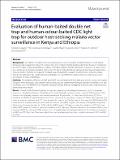| dc.contributor.author | Teshome Degefa, Delenasaw Yewhalaw, Guofa Zhou, Harrysone Atieli, Andrew K. Githeko & Guiyun Yan | |
| dc.date.accessioned | 2022-02-04T06:27:47Z | |
| dc.date.available | 2022-02-04T06:27:47Z | |
| dc.date.issued | 2020 | |
| dc.identifier.uri | https://repository.maseno.ac.ke/handle/123456789/4865 | |
| dc.description | https://doi.org/10.1186/s12936-020-03244-2 | en_US |
| dc.description.abstract | Surveillance of outdoor host-seeking malaria vectors is crucial to monitor changes in vector biting behaviour and evaluate the impact of vector control interventions. Human landing catch (HLC) has been considered the most reliable and gold standard surveillance method to estimate human-biting rates. However, it is labour-intensive, and its use is facing an increasing ethical concern due to potential risk of exposure to infectious mosquito bites. Thus, alternative methods are required. This study was conducted to evaluate the performance of human-odour-baited CDC light trap (HBLT) and human-baited double net trap (HDNT) for outdoor host-seeking malaria vector surveillance in Kenya and Ethiopia. | en_US |
| dc.publisher | BMC | en_US |
| dc.subject | Malaria vectors, Outdoor host-seeking, Surveillance, Human-odour-baited CDC light trap, Human-baited double net trap, Kenya, Ethiopia | en_US |
| dc.title | Evaluation of human-baited double net trap and human-odour-baited CDC light trap for outdoor host-seeking malaria vector surveillance in Kenya and Ethiopia | en_US |
| dc.type | Article | en_US |

